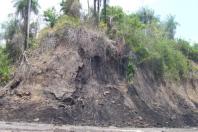Utah’s oil shale, tar sands in for a bumpy ride
By Brian Maffly
The Salt Lake Tribune
First Published May 07 2013
Eastern Utah might be blessed with abundant oil shale and tar sands, but getting those "unconventional" hydrocarbons out of the ground, processed and delivered to market still face financial, technical and regulatory obstacles, according to speakers Tuesday at a University of Utah energy conference.
And that’s not to mention activist pushback, which conference goers got to experience when a small group of well-attired demonstrators briefly commandeered the conference during a keynote by Juan Palma, the U.S. Bureau of Land Management’s Utah director.
"Our land and water should be held for the good of everyone. Our lungs are not yours to fill with toxic dust," a protester shouted at the event staged by the U.’s Institute for Clean and Secure Energy in the Rice-Eccles Stadium tower. "We are standing up for life. You are profiting from death."
Palma all but ceded the podium to the protesters, associated with Utah Tar Sands Resistance, who railed against petroleum extraction for about 10 minutes before U. police escorted them away. Neither "secure" nor "clean," unconventional energy is the last gasp of a industry, protesters argued during their uninvited presentation.
"There are a lot of concerns about the issues we deal with. That is the beauty of our American democracy," Palma said. "We can hold a variety of views on the multiple use of our public lands. Anything we do will allow for public comment."
His agency, which administers 42 percent of Utah’s land, has recently narrowed its Utah acreage of land open for oil shale and tar sands development to 360,000 and 132,000, respectively. Under a new rule, developers must show their technologies work and can yield petroleum in an economically and environmentally sound manner before moving onto large-scale development.
Still, this industry may face formidable hurdles in the marketplace and with federal regulations protecting water and air quality and endangered species. Investors, energy purchasers and insurers prefer working in proven industries, according venture investor Robert Wood.
"Financing unconventional energy is going to be tough," Wood said. "Unconventional fuels are to some extent unproved and financing is all about allocating risk. Conventional lenders are not interested in taking on unquantifiable risk."
Adding to the uncertainty is the Uinta Basin’s transportation network. It is not extensive enough to accommodate anticipated production growth in conventional petroleum, according to economist Neil Pogorelsky. While natural gas exits the state in pipelines, trucks move most of the liquids. Poised to release a study on this issue, he predicted a serious transportation shortfall, which could render as much as $30 billion in anticipated production unmovable.
Anne Mariah Tapp spoke on behalf of the Grand Canyon Trust, which opposes oil shale development on the region’s public lands.
"We are talking about strip mining, the complete use of the permit area," Tapp said. "The proposed development is occurring on top of aggressive conventional energy development. There is a limit to the environmental carrying capacity of the [Uinta] Basin that is going to be reached."
She predicted the federal Clean Air, Clean Water and Endangered Species acts will complicate permitting. That is particularly the case in places with superb wildlife and scenic values, such as the Book Cliffs.
"This area is valued by a range of interest groups beyond the radical environmental community," Tapp said. Meanwhile, that community appears to be mobilized.
"We will see direct action. We saw it today," Tapp said. "You will see people showing at mines and chaining themselves to bulldozers."
http://www.sltrib.com/sltrib/news/56275796-78/utah-energy-oil-sands.html.csp


